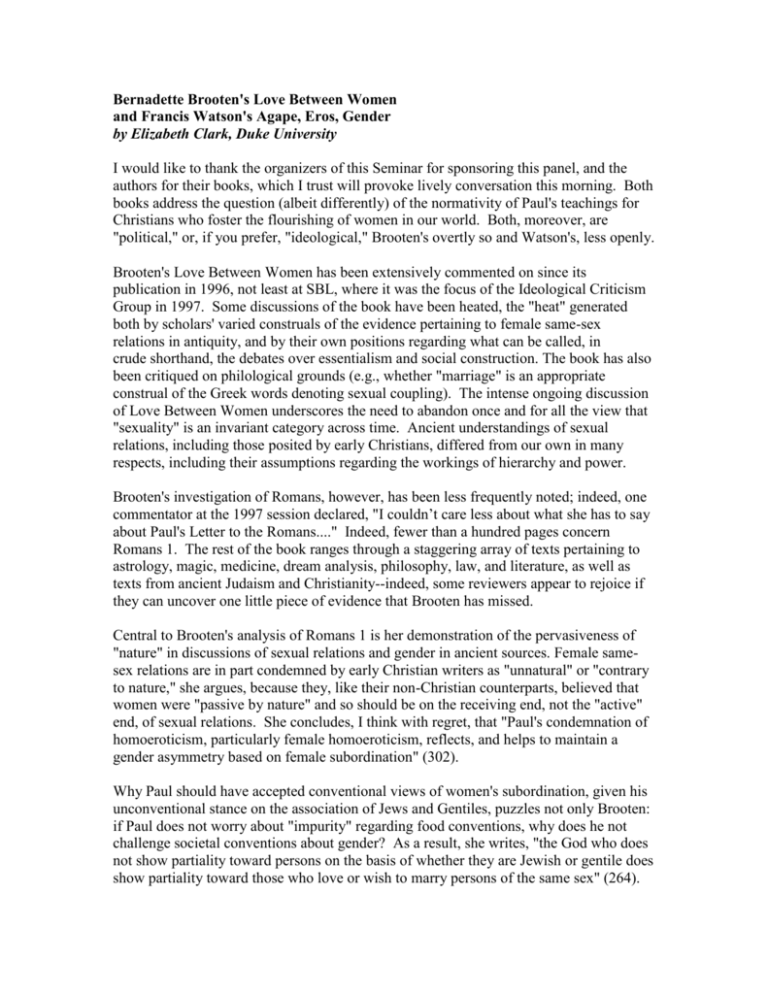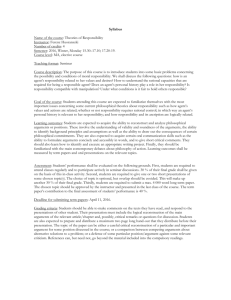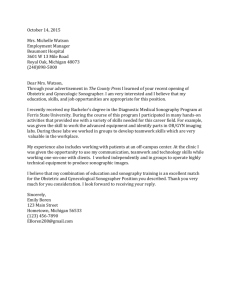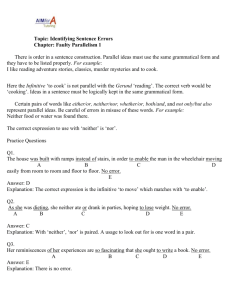
Bernadette Brooten's Love Between Women
and Francis Watson's Agape, Eros, Gender
by Elizabeth Clark, Duke University
I would like to thank the organizers of this Seminar for sponsoring this panel, and the
authors for their books, which I trust will provoke lively conversation this morning. Both
books address the question (albeit differently) of the normativity of Paul's teachings for
Christians who foster the flourishing of women in our world. Both, moreover, are
"political," or, if you prefer, "ideological," Brooten's overtly so and Watson's, less openly.
Brooten's Love Between Women has been extensively commented on since its
publication in 1996, not least at SBL, where it was the focus of the Ideological Criticism
Group in 1997. Some discussions of the book have been heated, the "heat" generated
both by scholars' varied construals of the evidence pertaining to female same-sex
relations in antiquity, and by their own positions regarding what can be called, in
crude shorthand, the debates over essentialism and social construction. The book has also
been critiqued on philological grounds (e.g., whether "marriage" is an appropriate
construal of the Greek words denoting sexual coupling). The intense ongoing discussion
of Love Between Women underscores the need to abandon once and for all the view that
"sexuality" is an invariant category across time. Ancient understandings of sexual
relations, including those posited by early Christians, differed from our own in many
respects, including their assumptions regarding the workings of hierarchy and power.
Brooten's investigation of Romans, however, has been less frequently noted; indeed, one
commentator at the 1997 session declared, "I couldn’t care less about what she has to say
about Paul's Letter to the Romans...." Indeed, fewer than a hundred pages concern
Romans 1. The rest of the book ranges through a staggering array of texts pertaining to
astrology, magic, medicine, dream analysis, philosophy, law, and literature, as well as
texts from ancient Judaism and Christianity--indeed, some reviewers appear to rejoice if
they can uncover one little piece of evidence that Brooten has missed.
Central to Brooten's analysis of Romans 1 is her demonstration of the pervasiveness of
"nature" in discussions of sexual relations and gender in ancient sources. Female samesex relations are in part condemned by early Christian writers as "unnatural" or "contrary
to nature," she argues, because they, like their non-Christian counterparts, believed that
women were "passive by nature" and so should be on the receiving end, not the "active"
end, of sexual relations. She concludes, I think with regret, that "Paul's condemnation of
homoeroticism, particularly female homoeroticism, reflects, and helps to maintain a
gender asymmetry based on female subordination" (302).
Why Paul should have accepted conventional views of women's subordination, given his
unconventional stance on the association of Jews and Gentiles, puzzles not only Brooten:
if Paul does not worry about "impurity" regarding food conventions, why does he not
challenge societal conventions about gender? As a result, she writes, "the God who does
not show partiality toward persons on the basis of whether they are Jewish or gentile does
show partiality toward those who love or wish to marry persons of the same sex" (264).
I think that Brooten's reading of Paul in this respect is correct, and I will offer an example
to illustrate how notions of female subordination play out in some Church Fathers'
critiques of same-sex relations. But first, I would like to pose a question to Brooten: she
argues that Romans 1 assumes a universal human sinfulness, i.e., that Romans 1 does not
pertain merely to Gentile idolatry, as many scholars have argued (and as patristic authors
such as Athanasius and Origen assumed ). Does she believe that opting for "universal
human sinfulness" is necessary for her emphasis on "nature" as a central crux of the
debate? Does she think that she would lose an essential prop to her main argument if she
abandoned the "universalizing" thesis? Moreover, Brooten claims that Paul's argument is
undergirded by "natural law theology," yet it is not clear why one needs such an elaborate
(and possibly anachronistic) construct simply to highlight an author's appeal to "nature."
Could not "nature" be uncoupled from a somewhat problematic "natural law theology"
and still do its work?
Brooten is, however, entirely correct in her claim that appeals to "nature" were often used
by the Church Fathers to buttress conventional notions of female subordination and
gender relations. As I have argued elsewhere, "nature" is repeatedly used by patristic
authors to signal women's weakness and delicacy (a disability that precludes
their assumption of certain roles within and without the church), and is the leading
argument against same-sex relations, bestiality, long hair on men, cosmetics, women's
hair and headcoverings, adultery, and non-vaginal forms of heterosexual intercourse. In
addition, women's subjection to men is seen as in accordance with "nature"--although
whether this subjection occurred at the time of creation or after the first sin is debated
(interestingly, authors who argue "after the first sin" should concede that "nature" can
change or be changed--but that option would lead them into too many black holes to
countenance). The appeal to "nature," in any event, is the central controlling device in
patristic literature for discourse on sex and gender.
Brooten is also correct that there are surprisingly few patristic texts that deal with
Romans 1:26-27. Among the authors she cites is John Chrysostom, bishop of Antioch
and then of Constantinople in the late fourth and opening years of the fifth century,
whose writings are a treasure-trove for scholars exploring early Christian notions of
gender. Chrysostom explicates Romans 1:26-27 in his Homily 4 on Romans. He here
conceives of same-sex relations as stemming not from idolatry, but from a mania for
"excess," too much of "the easy life": men and women had sexual partners in each other,
but they wanted "more," he argues, and hence went beyond the "limits" that nature
establishes (1;3). The devil--here held responsible--prompts a series of gender wars, not
least of which is a war against "nature" herself (2); thus "sedition" is a favorite topos of
Chrysostom's argument. He also construes same-sex relations as "disease" (comparable
to the ill who crave dirt and stones as nourishment [1]); as "murder" (in that same-sex
relations bring to ruin the body as well as the soul[2]); as "madness" (comparable to the
insane who run about naked, smearing their bodies with filth [2], and proved by the fact
that those so accused take pleasure in the deed [1]); and as "treason" (to both male and
female "natures" [3]). Chrysostom also engages in some artfully-staged rhetorical
dithering as to whether either sex has actually changed into its "opposite" by same-sex
practices, but concludes rather that the persons so implicated have become a third
"something" (3). Likewise, the topos of chastely heterosexual animals who "keep to the
limits of nature" is introduced to shame those allegedly higher on the chain of being (3).
Most important, Chrysostom's arguments against same-sex relations are deeply
imbricated in notions of female subordination. He employs "shaming devices," positing
that the women's behavior is even more disgraceful than the men's, since women are
supposed to have ("by nature") a more finely developed sense of "shame." Moreover,
men were intended by God to serve as "instructors" to women, whose role was that
of "helper," according to Chrysostom's reading of Genesis 2, an intertext from which he
derives considerable mileage (1). In same-sex relations, by contrast, gender relations are
turned upside down ([2]--just as they are in "spiritual marriage" (now engagingly detailed
in Blake Leyerle's Theatrical Shows and Ascetic Lives) and in the case of "rich wives,"
who wrongly imagine that their independent means grant them male authority,
allowing them, not their husband, to be "the head." Chrysostom puts a no-brainer
question to his audience: would we not be filled with indignation if men were to suffer
labor pains and be brought to childbed? (Yes!) If so, why do we not feel similarly
outraged at this disgrace to male "nature"[3]? As is clear, a heavy rhetoric of female
subordination is built into such arguments, and I think that Brooten is correct to
emphasize the views on women's subjection that inhabit almost every discussion of
sexual relations by ancient Christian writers.
I turn now to Francis Watson's Agape, Eros, Gender. If I read Watson's position
correctly, he endorses a pro-woman politics, but one that is delimited so as to exist
compatibly with evangelical theology. From this perspective, the parts of the Bible that
on the surface appear less friendly to the aspirations and self-understanding of modern
women are given a "gentler" read--for example, Ephesians 5's directive to wives
to be subjected to their husbands is interpreted to mean that wives and husbands are in
mutual subjection to each other (228). By contrast, Watson rejects analyses of the Bible
informed by a "hermeneutics of suspicion," probably the dominant interpretive approach
among feminist scholars of the New Testament (222). Thus he admits that he does not
like "equality-language," as in the phrase "the discipleship of equals" (75). Rather, he
endorses a Barthian (Karl, not Roland) Mitmenschlichkeit as the proper Christian
approach to male-female relations, albeit with its most alarming expressions of female
subordination ("man is A, woman is B") smoothed away (237, 240). Thus Jesus is
represented, in Barthian parlance, as the one who "comes to disturb the peace of
masculine complacency and feminine acquiescence...."(39)
Watson sets himself the task of reading three passages--I Corinthians 11, Romans 7, and
Ephesians 5 (which he takes to be from Paul [223n.3])--over against three twentiethcentury authors, Virginia Woolf, Sigmund Freud, and Luce Irigaray, respectively. This is
clearly not an "historical" project (indeed, Watson decries a "hermeneutics of
historicism" [89]), but one in which readers are invited to use the texts to "think with"
(viii). Watson imaginatively explores how the twentieth-century writings might be seen,
from a certain perspective, as part of the Pauline Wirkungsgeschichte (ix). In this style of
reading, the modern texts and the ancient ones "speak" to one another, as if they
were synchronous. Even more radically, Freud can be understood as a "precursor" to
Paul in that Watson takes his writings as clearing the ground of prejudice so that our
contemporaries can "hear" Paul's message on sexuality (129); likewise, Paul and
Augustine are read as authors who in effect "rewrite" their successors, Freud and Irigaray
(206). Since a deficit of imagination is often displayed in these halls, I thank Professor
Watson for supplying some. And in his choice of contemporary writers, the fact that two
of three are women bespeaks his concern to attend to women's views.
I would be interested to know, however, why Watson chose Virginia Woolf and Luce
Irigaray as the most stimulating "talking partners" for Paul (the reasons for the choice of
Freud, paired with a discussion of Romans 7, seem more obvious). As far as I can
ascertain, Virginia Woolf's "separatist" line of thought offers Watson a way to reflect on
the veiling of women in I Corinthians 11, seemingly a "separatist" move, as rather
providing a space in which woman is not the object of man's desiring gaze (52-53, 78);
hence woman and man can come together in a relationship of agape. In this reading,
even Paul's often-maligned injunction on veiling is taken to harbor a feminist dimension.
I wonder if this interpretation owes anything to debates within contemporary Islamic
world? (Gayatri Spivak's now-classic essay, "Can the Subaltern Speak?", might here
provide another provocative talking partner.)
Likewise with Irigaray, who, in Watson's reading, argues that in the dominant reign of
eros in which we live, sex is "compulsory" (although motherhood is not) (190, 196);
Watson posits that Irigaray's view might profitably be "corrected" by the author of
Ephesians, for whom eros is sanctified by agape (212). Thus Watsons uses the cases of
Woolf and Irigaray to show how the ancient Christian tradition "trumps" these twentiethcentury writers. But perhaps there is more, or something different, at stake in Watson's
choices of these twentieth-century.
As for Freud and Romans 7, my fellow panelist Serene Jones will deal more with this
pairing. I acknowledge the utility of "the darker Freud" who believed that repression will
always be with us for Watson's project of interrupting Enlightenment narratives of a
"natural," liberated sex (101, 107, 125). But I am nonetheless a little puzzled by the
resolutely sexual interpretation of Paul's "war between flesh and spirit" that inhabits this
chapter. Although I am not a NT scholar, I had imagined (perhaps incorrectly?) that the
direction of twentieth-century NT scholarship had been to distance this "war" from its
earlier Christian positioning within the realm of sexuality.
Having rejected the various hermeneutical approaches mentioned above, Watson states
that "the appropriate criteria for judging [the Pauline texts] are available to us only
through the texts themselves" (ix); the text should be allowed "to unfold itself in its own
way" (89). Moreover, he endeavors to uncover the "intentions" of Paul (43, 55,
131). Since I do not believe that texts "speak for themselves," and am fairly skeptical
about our ability to uncover an author's intentions, I am, not surprisingly, dubious about
this aspect of Watson's project. But taking him on his own terms, I would further argue
that he does not always let texts "speak for themselves," and hence at times seems to
violate his own principles. Let me give an example or two.
First, there is the matter of the Pauline text on matters sexual that receives no "voice"
whatsoever, I Corinthians 7. We learn only on page 208 that this chapter contains a
message for those whose "calling is not to become 'one flesh' in marriage." But what if
we presume, as I do, that this is the central Pauline text to be privileged in any discussion
of Paul's views on male-female relations and marriage? The Christian Church in the
West up to the time of the Protestant Reformation clearly thought that it was. But if you
were to privilege I Corinthians, you (obviously) would not have the present book, whose
message is resolutely pro-heterosexual, pro-marital, and pro-procreative (e.g., 251). I
would be interested to know why Professor Watson decided to bypass I Corinthians 7.
But back to the question of whether texts are here allowed to speak for themselves. One
example in which Watson seems not to follow his own principle, namely, lies in his
interpretation of Augustine's views on contraception. I think that there is no way one can
take Augustine not to oppose "family planning," as Watson calls it (160); contraception
was part of Augustine's Manichean past that he firmly and repeatedly disavowed. The
view that Watson attributes to Augustine--namely, that if a married couple intends
children at some time, individual acts of sexual intercourse that make use of
contraception are justifiable--finds no support whatsoever in Augustine's writings, for
whom even the mental desire to preclude conception was as culpable as those "evil
appliances" he decried. Nor did Augustine believe, until the very end of his life when
his views on sexual functioning were attacked as heretical, that physiological excitation
would have been necessary for reproduction at the time of human creation (as is implied
by Watson on p. 105); for Augustine, the physiological symptoms of sexual excitement
are an aberration brought on by the first sin and hence are not constitutive of original
"human nature." To argue that contraception is allowable for married couples who
intend sometime to have children, or to have more children, is not an Augustinian stance,
but one adopted by liberal Catholics in the 1960s; the argument failed to win over the
Pope and his advisors, who cited the Augustinian-derived arguments of the 1930
encyclical, Cast Connubii in his response. I do not think that Augustine has here been
allowed to "speak for himself."
If we were to seek an "effective history" closer to Paul's own time, we could readily note
that patristic authors did not understand the Pauline message as Watson does. For
example, the veiling of women in I Corinthians 11 is read squarely in tandem with a
notion of women's subjection by Augustine, Ambrose, Jerome, and Chrysostom. In
Pelagius' words, Paul accords to man "the image" but to woman "the glory" because he is
free, while she was commanded to be subject to him. And if you protest that Pelagius is
a "heretic" and hence can't be counted, how about John Chrysostom, a saint, who links I
Corinthians 11:7-10 with Genesis 3:16, that woman is submitted to the man, who is,
Chrysostom writes, "like God in that he has no superior and reigns over everything"?
Likewise with patristic interpretations of Ephesians 5: woman's submission and male
superiority are the dominant notes. Moreover, the phrase in Ephesians 5: 27, "no spot or
wrinkle," is taken to forbid second marriage (thus Origen ) and divorce (thus Ambrose ),
while Jerome interprets Christ's "spotless and wrinkleless" love for his bride the Church
as an admonition to husbands to love their wives by living in chastity, meaning (in
Jerome's vocabulary), "without sex." In other words, the early Christian understanding
of Paul's words in these passages either stressed the subordinate status of women and/or
advocated a more ascetic form of marital relation than Watson's book portends. But,
Watson might reply, these passages show quite precisely (as he puts it) "the perversity of
the mind of the church," which the "mind of Christ" exposes (37).
Thank you, the audience, for your interest, and the authors for provoking this discussion.








